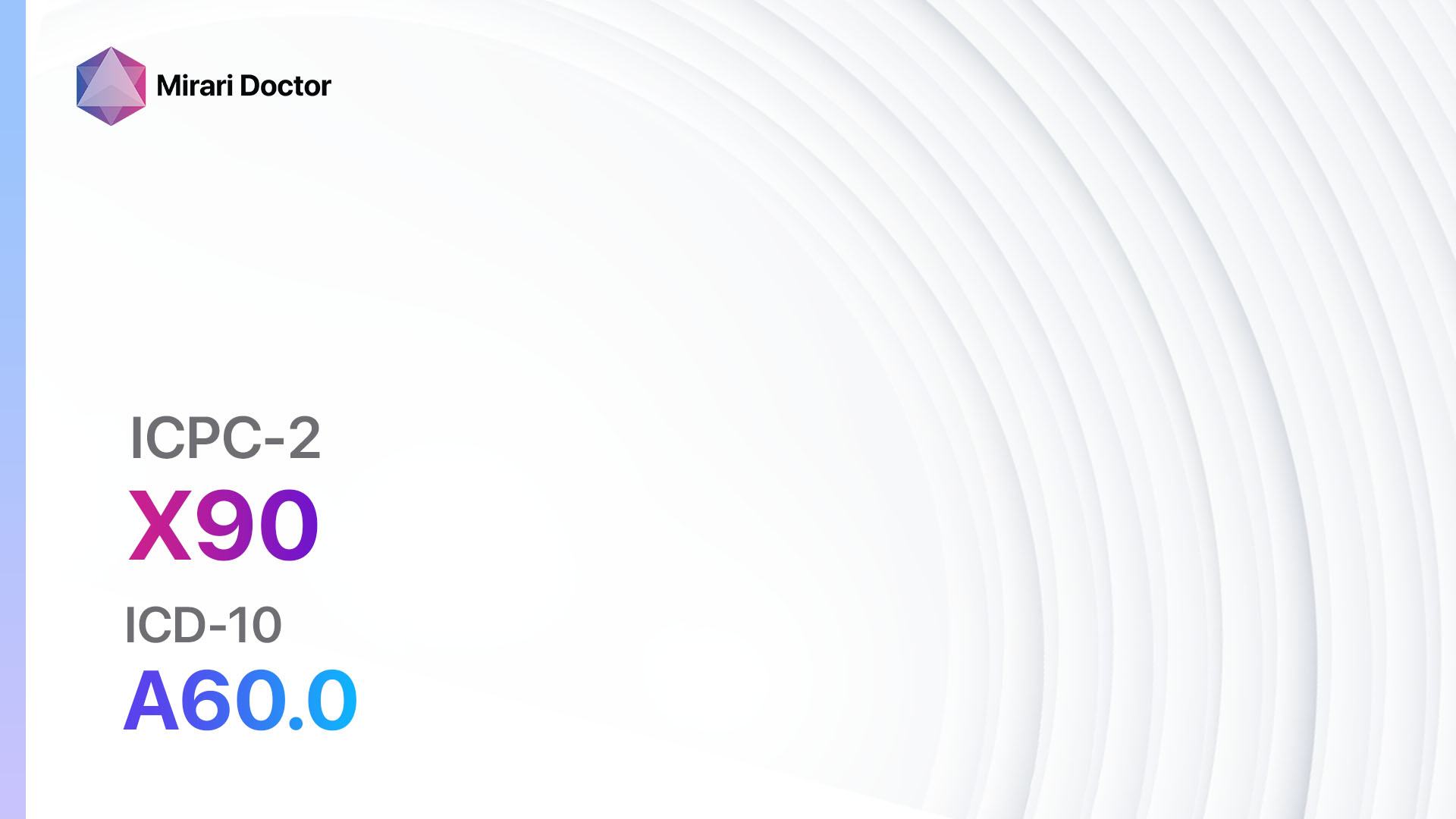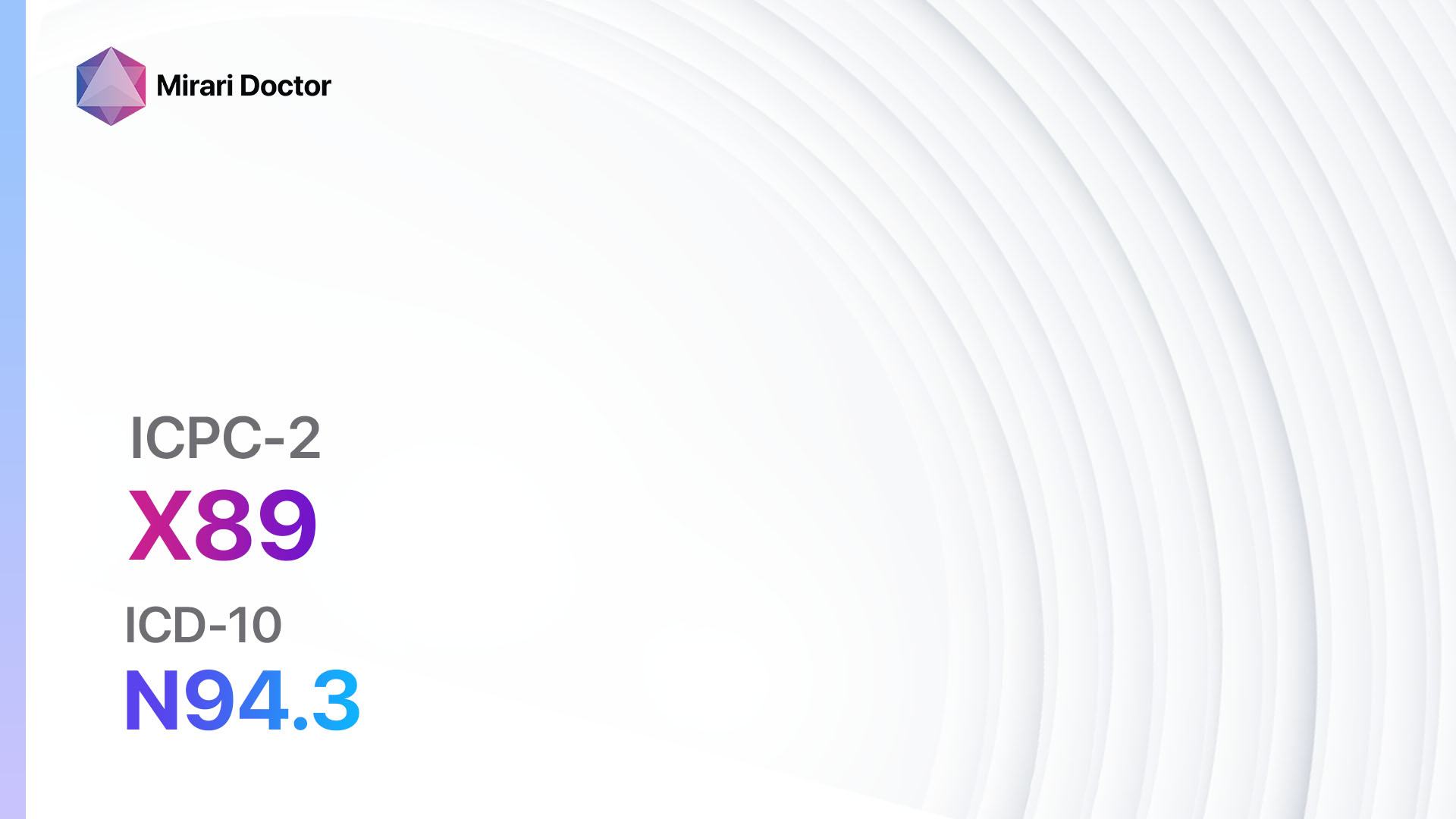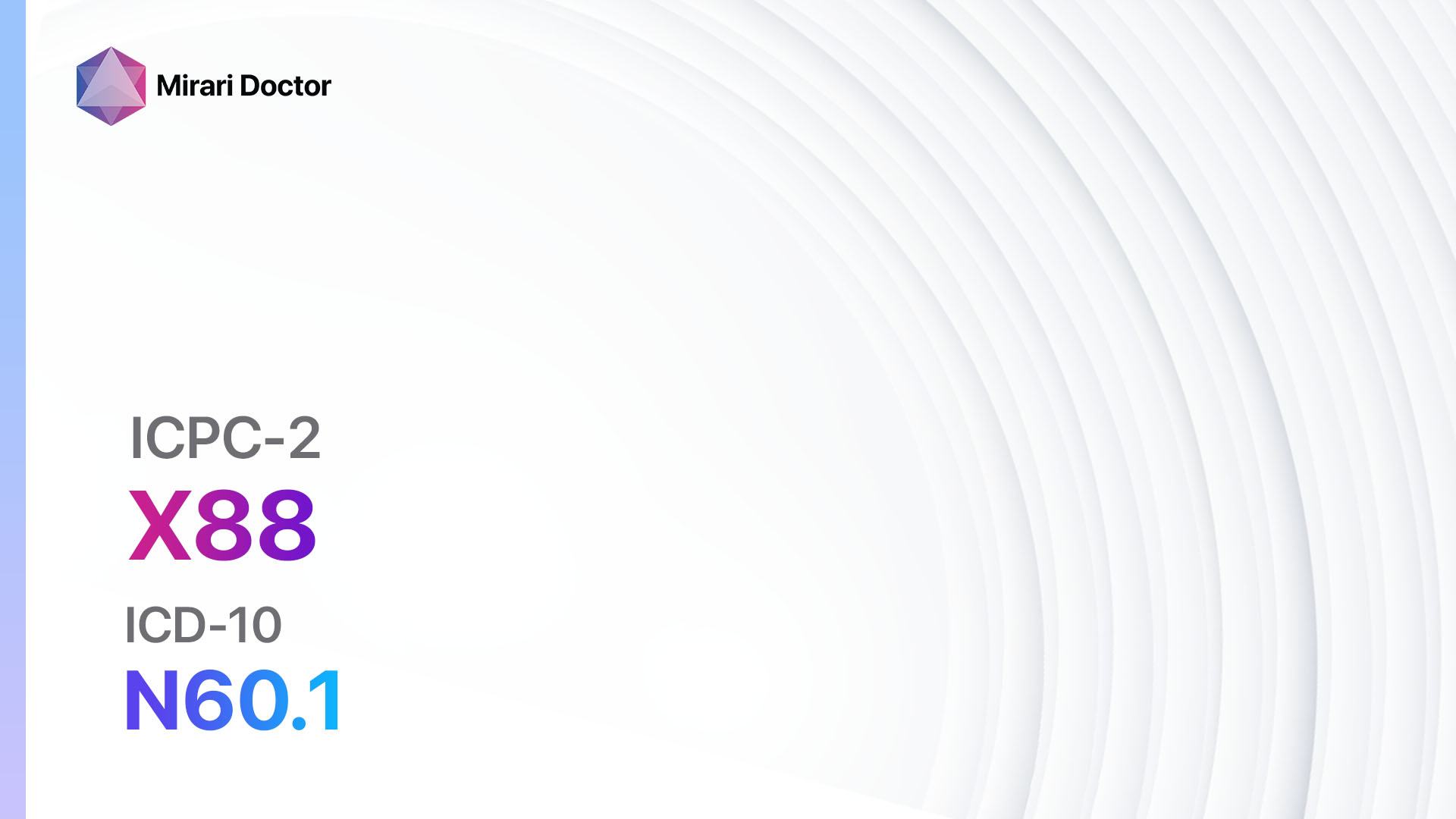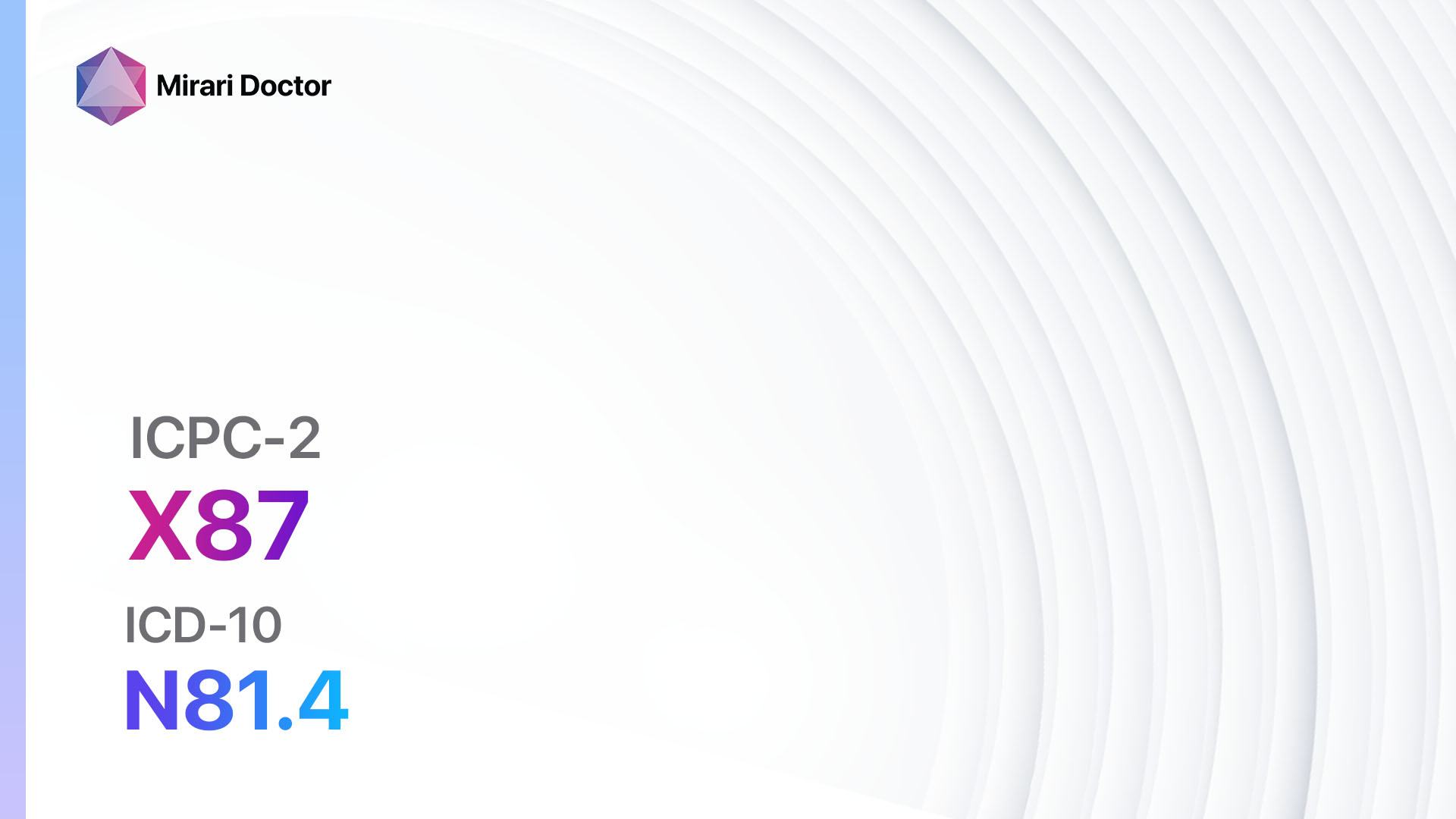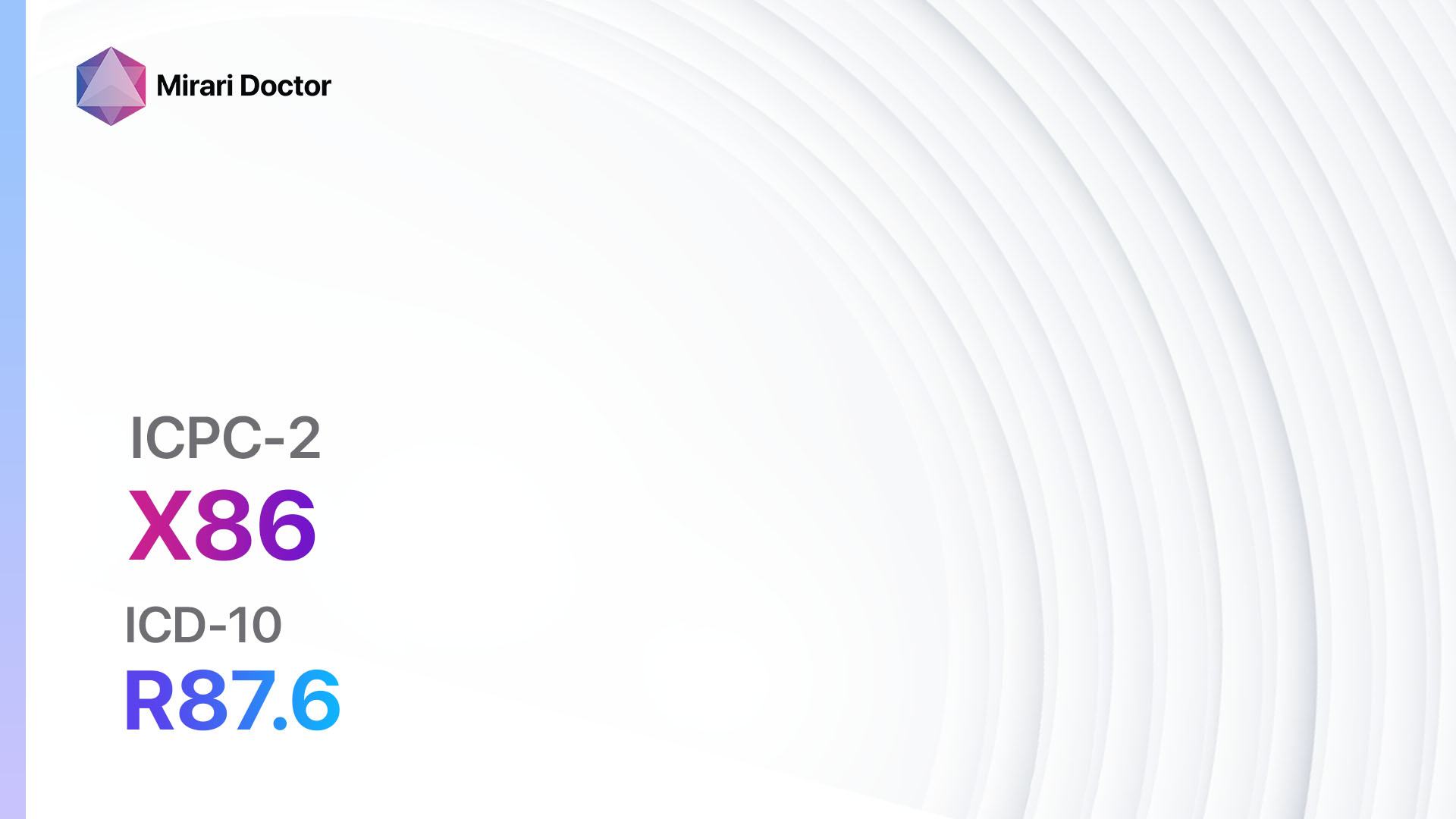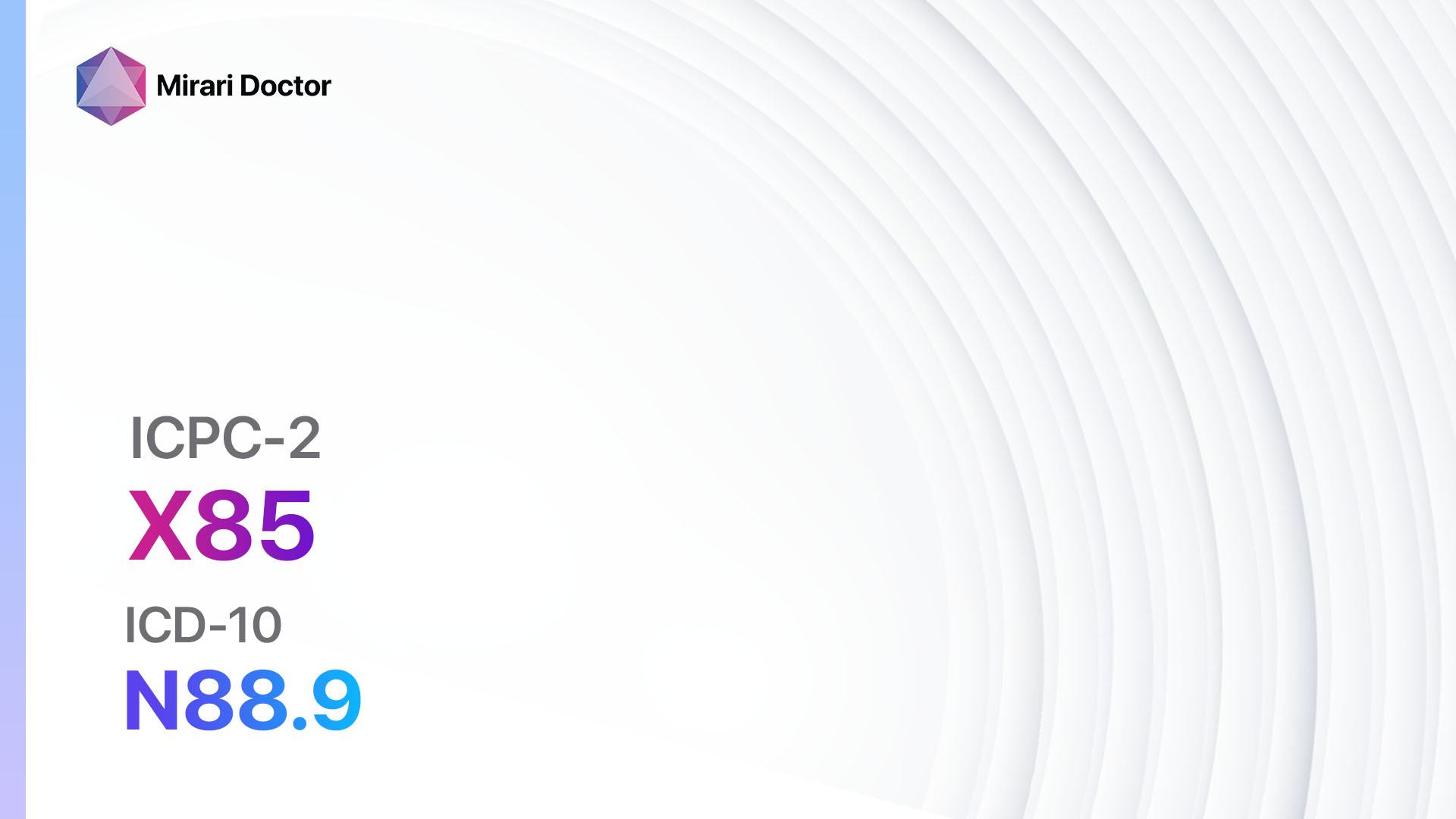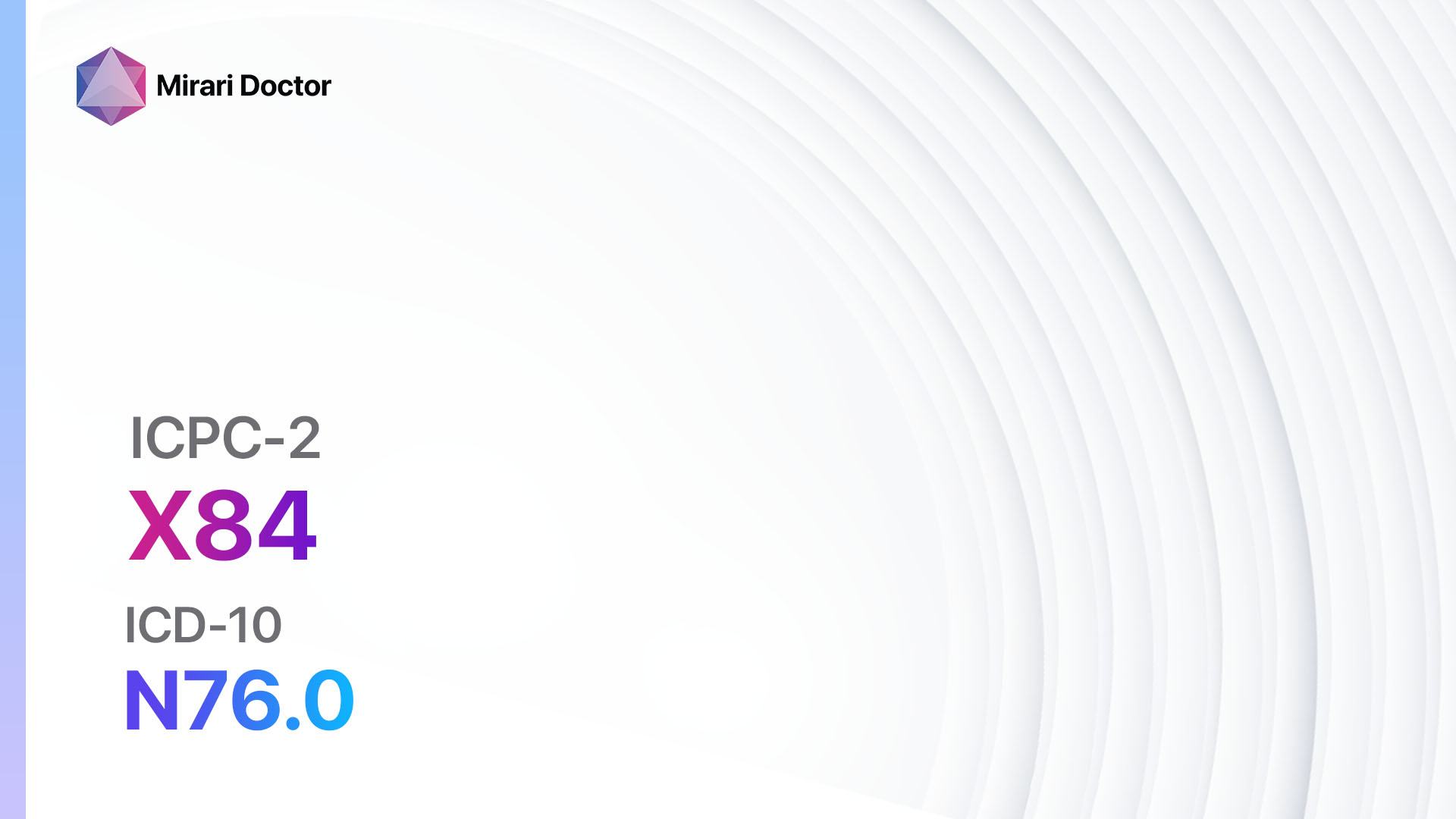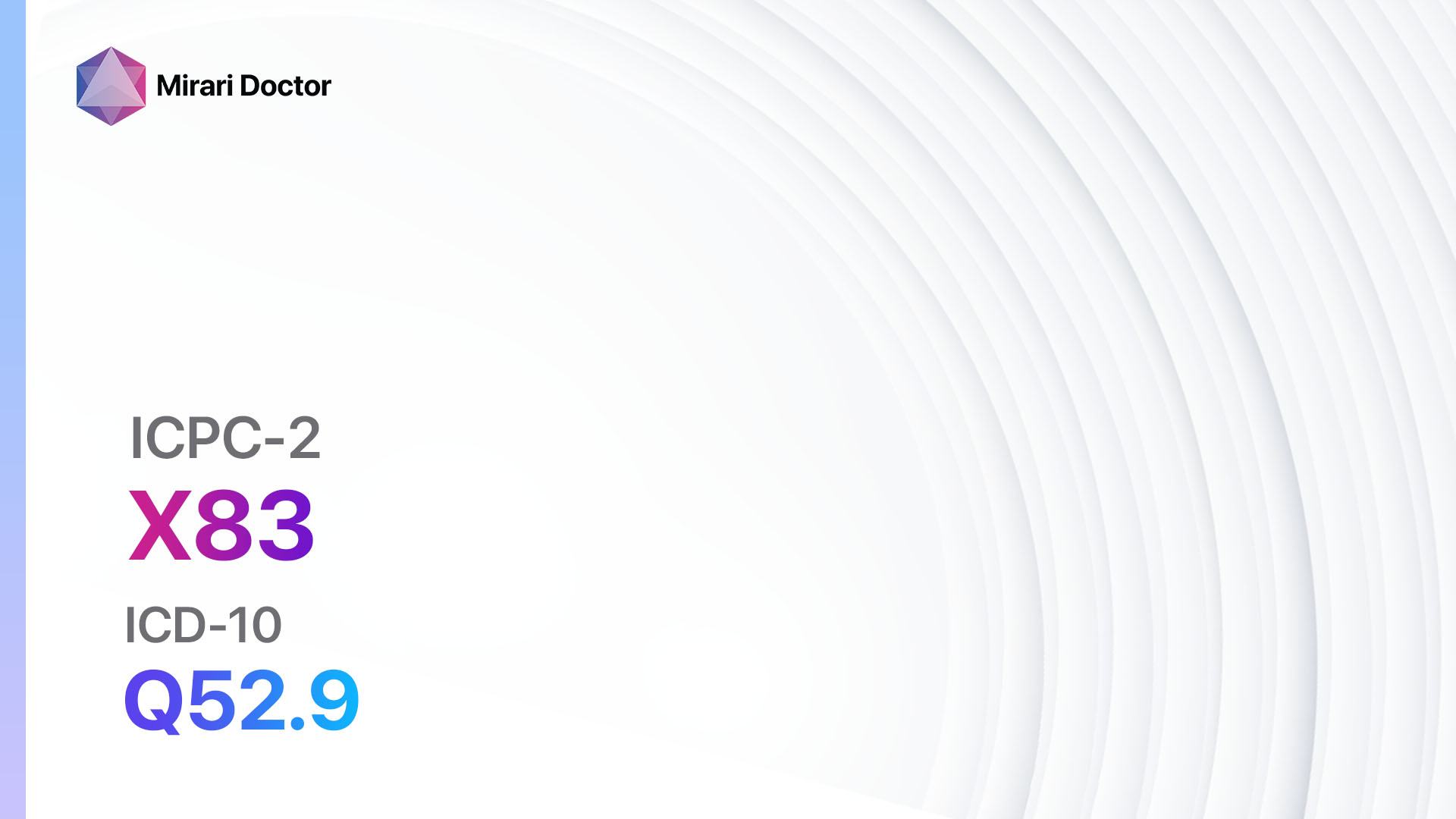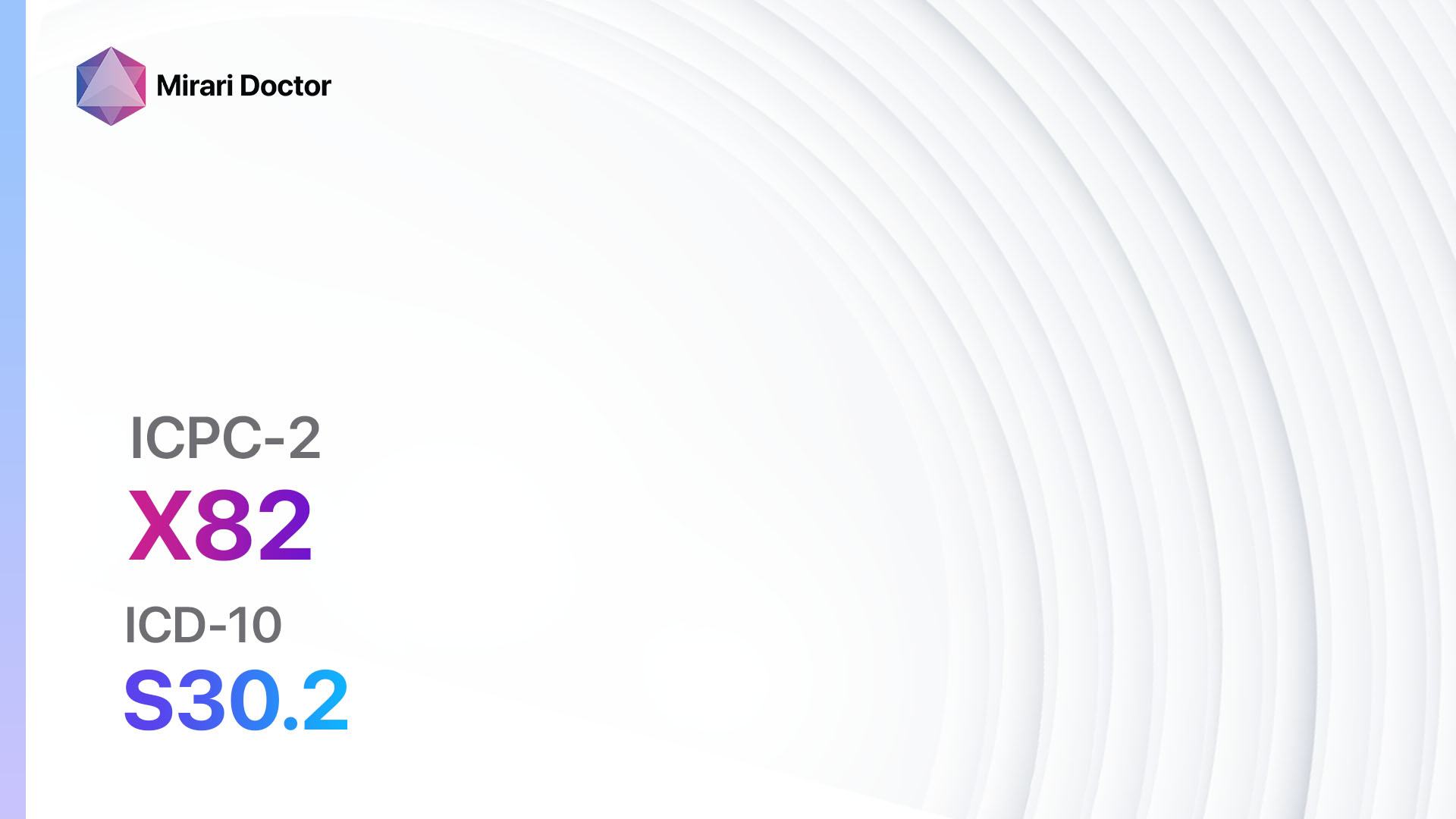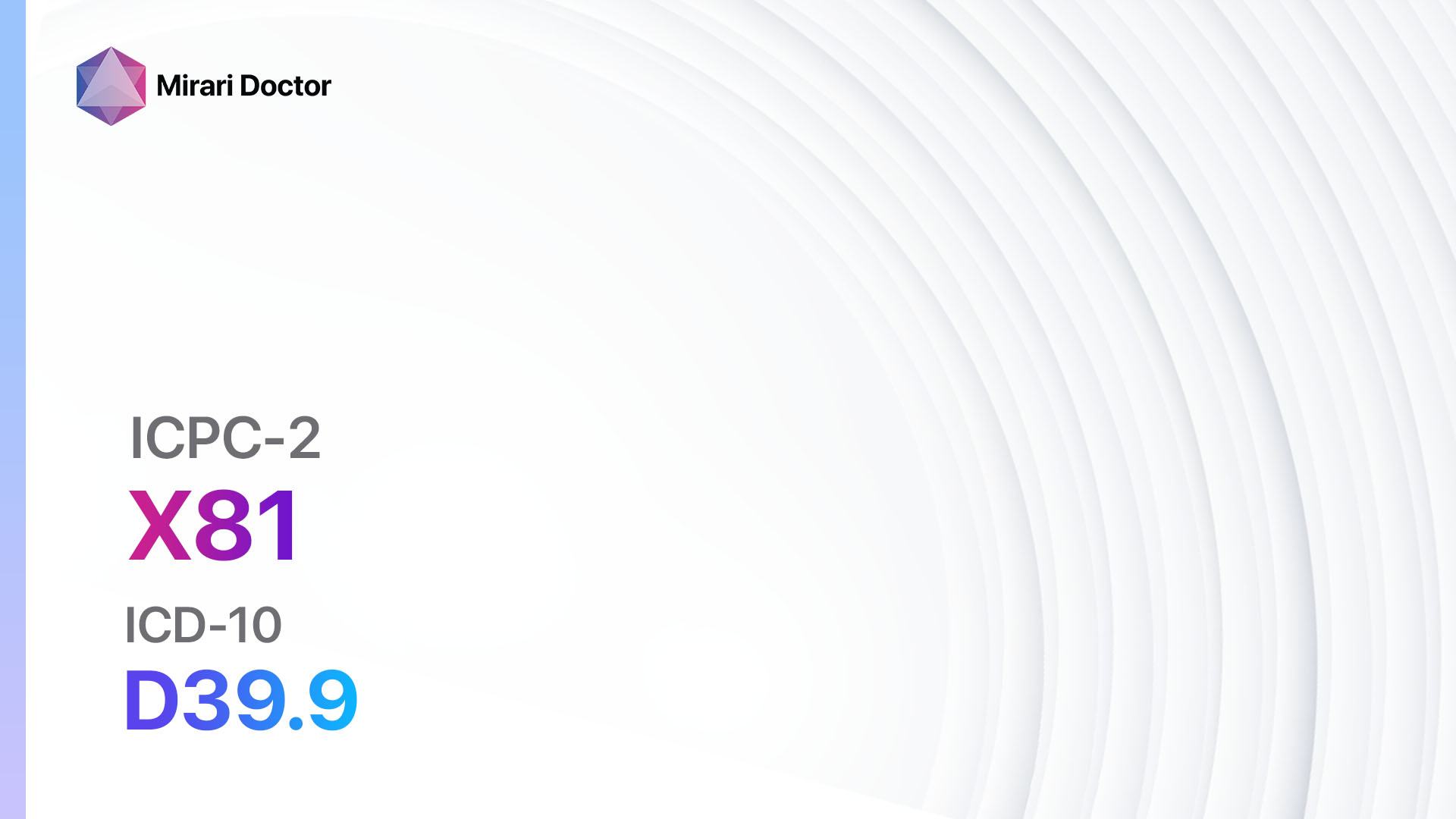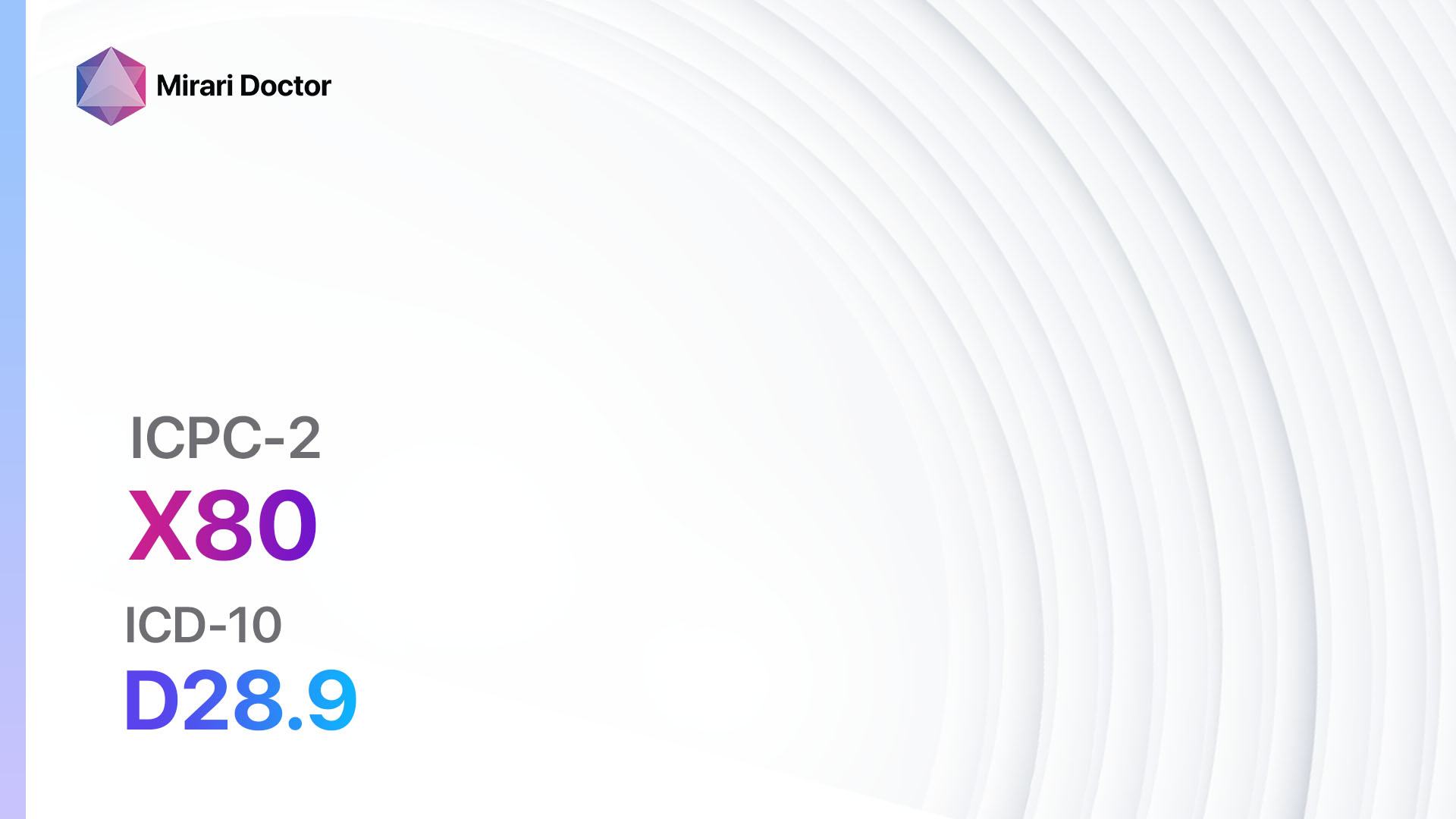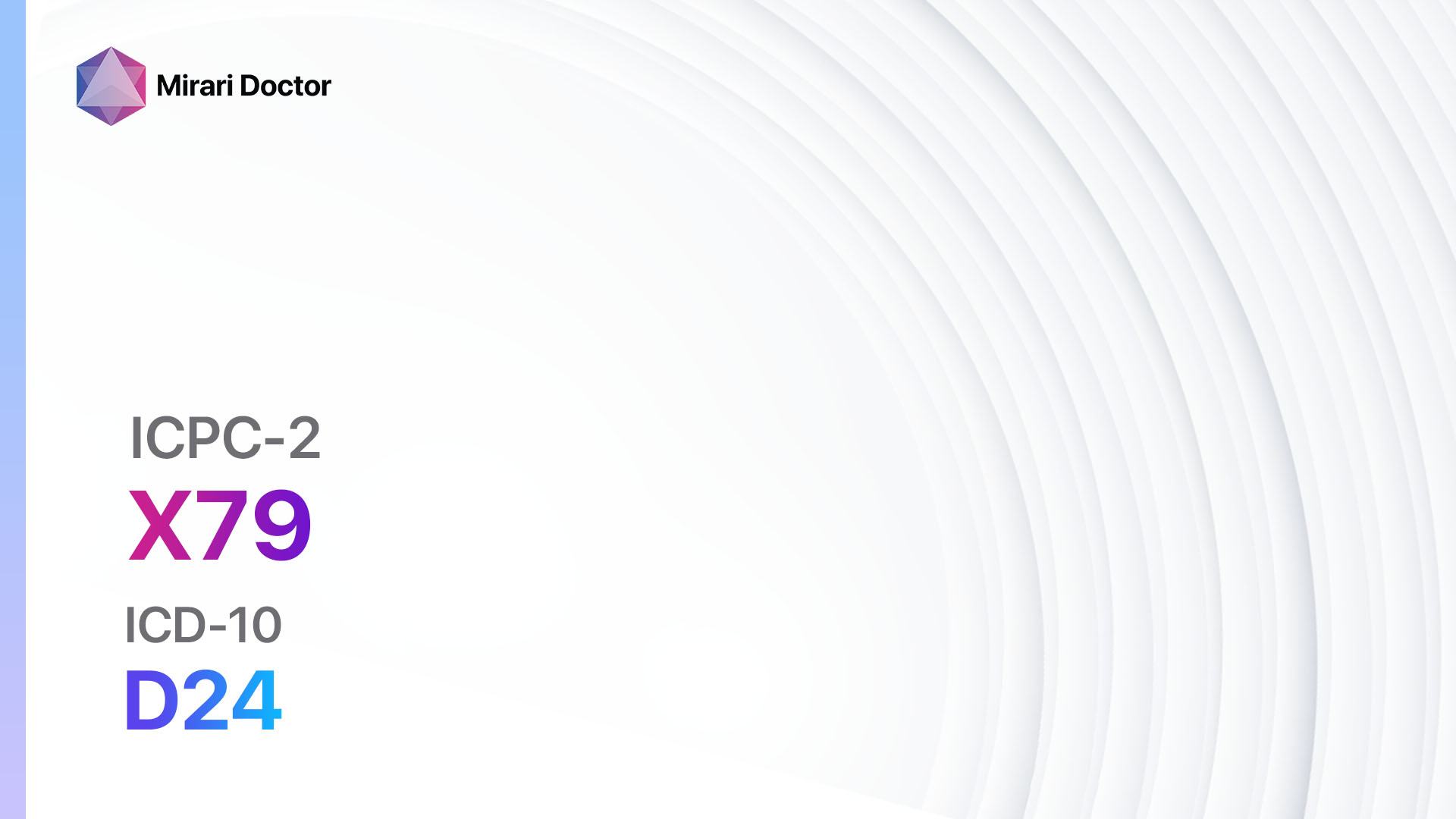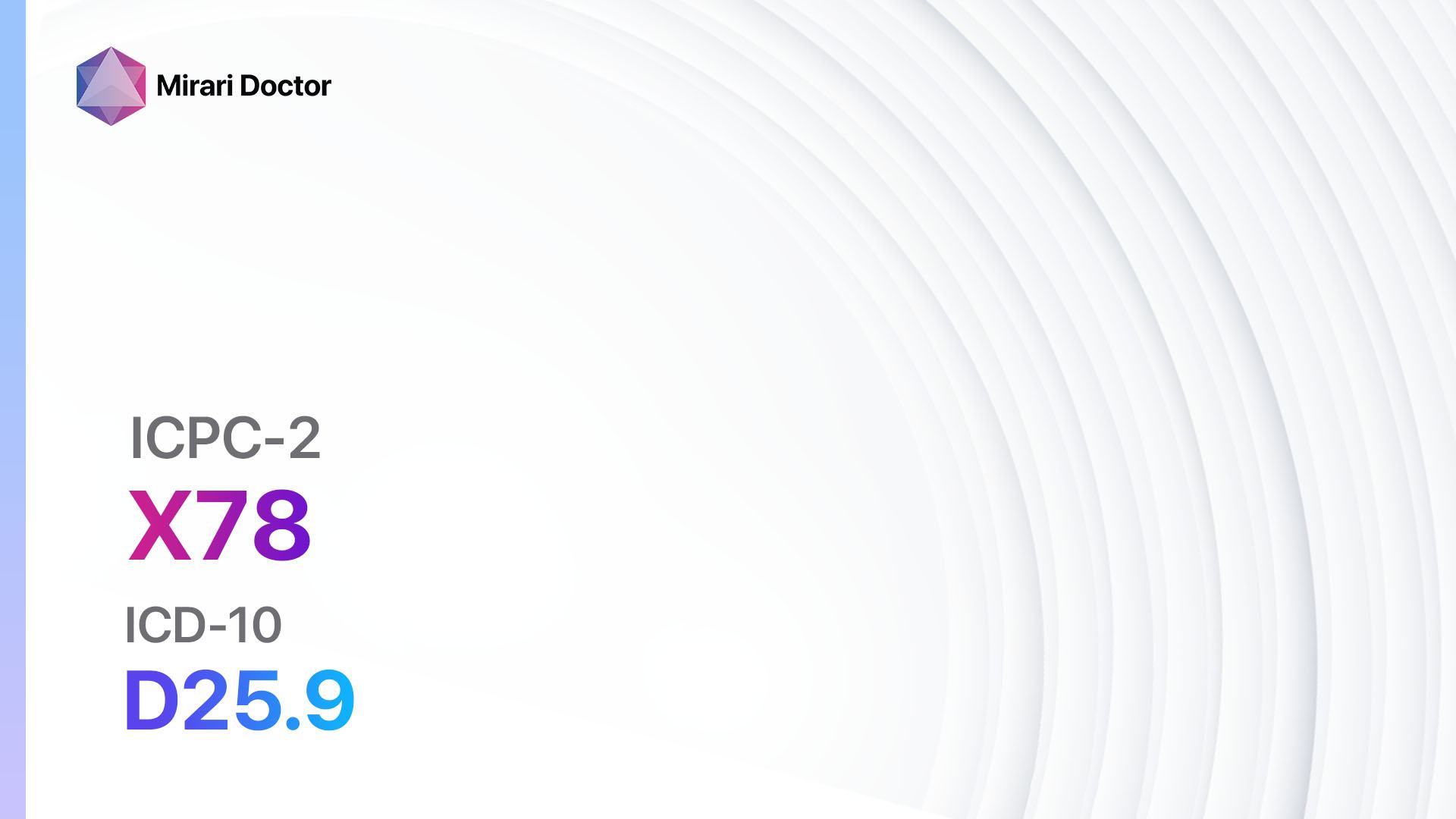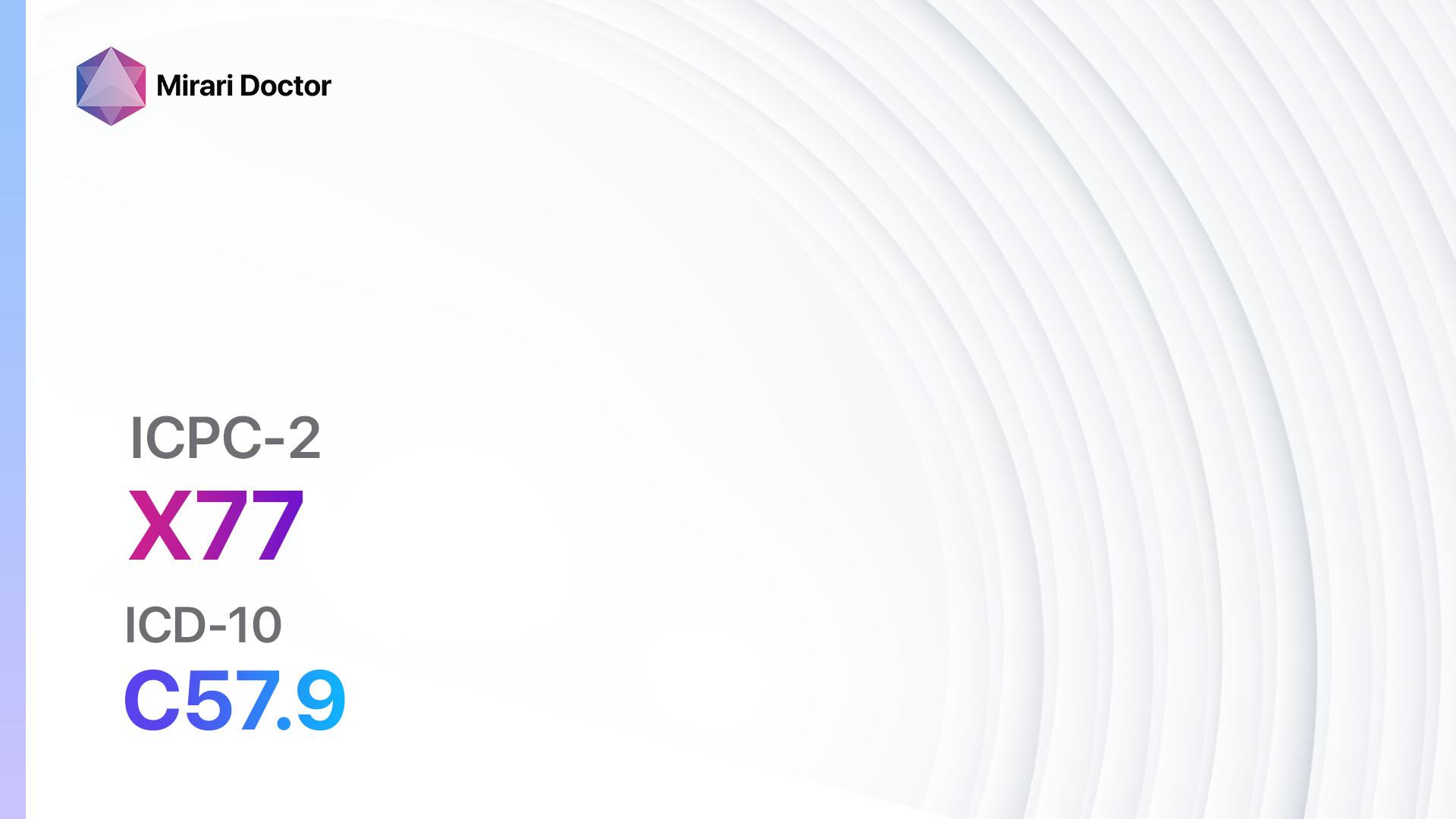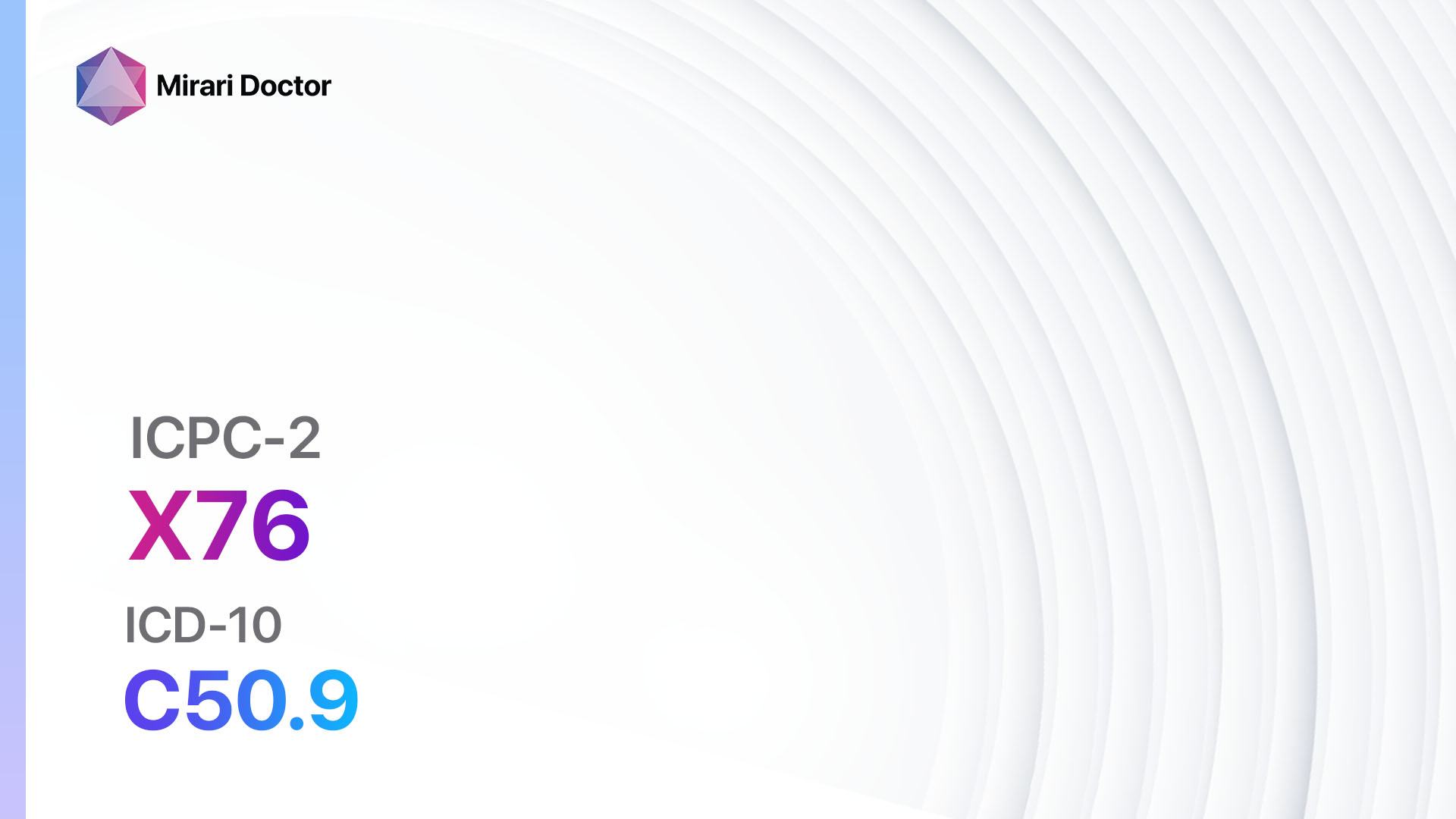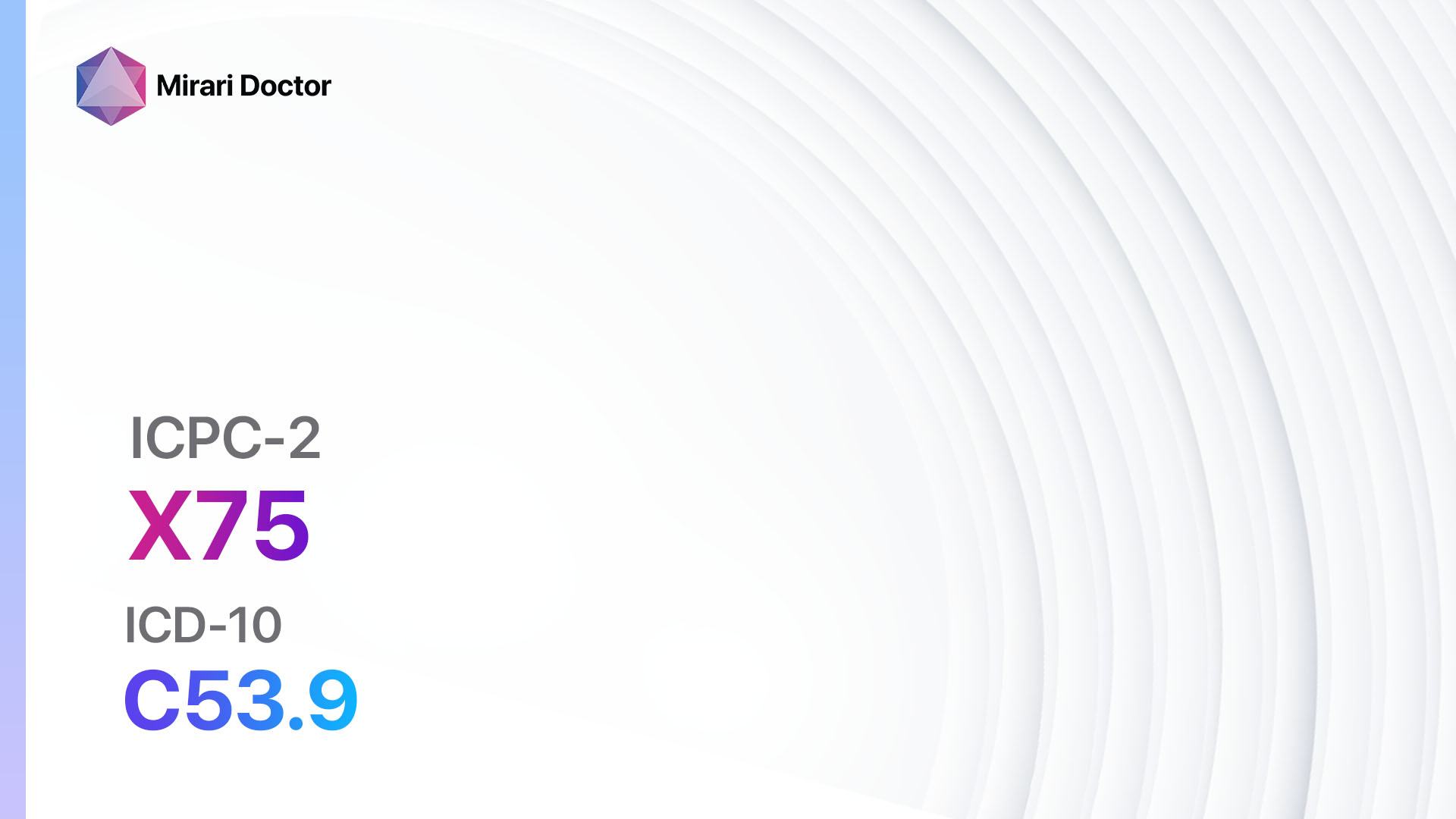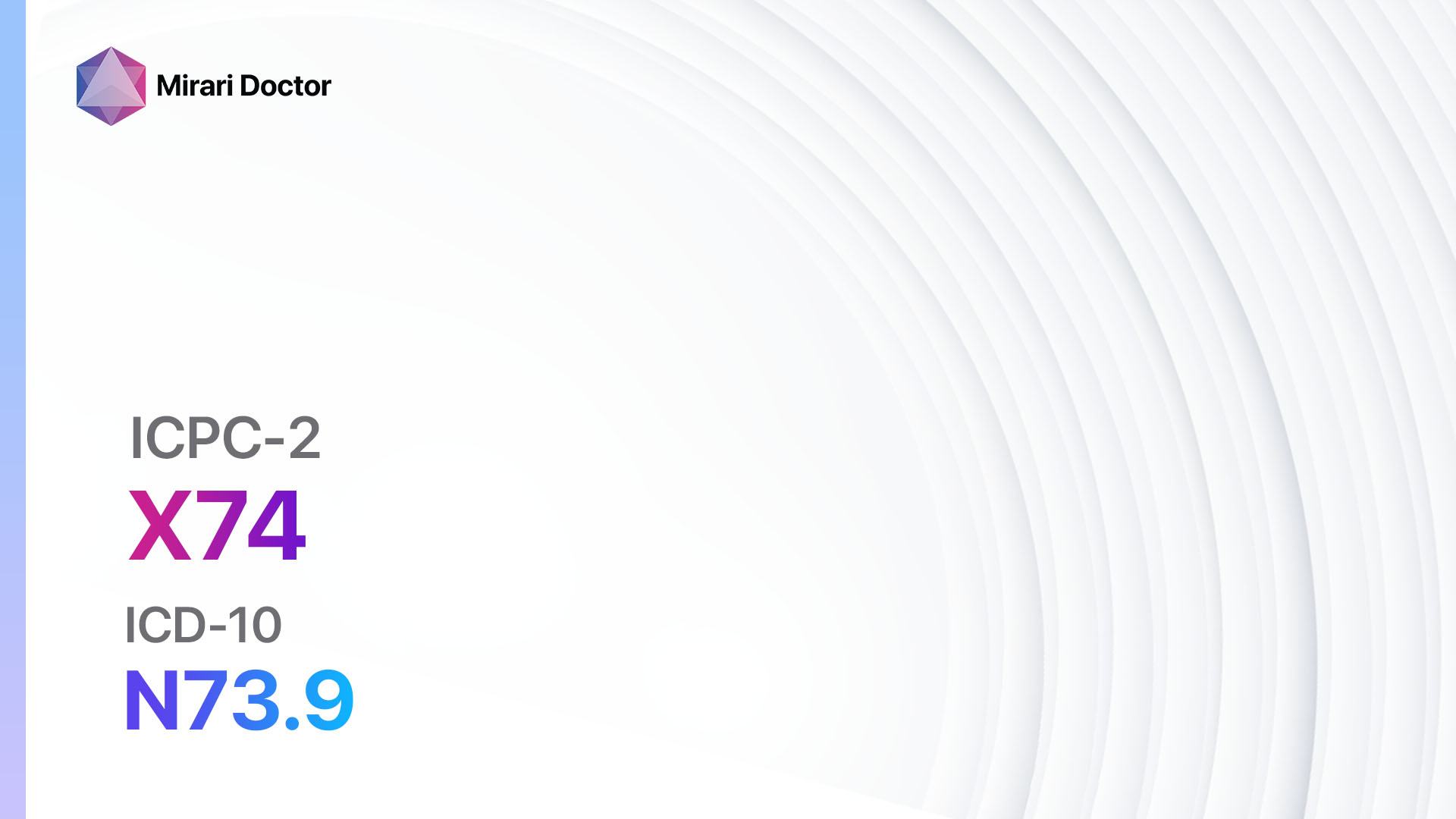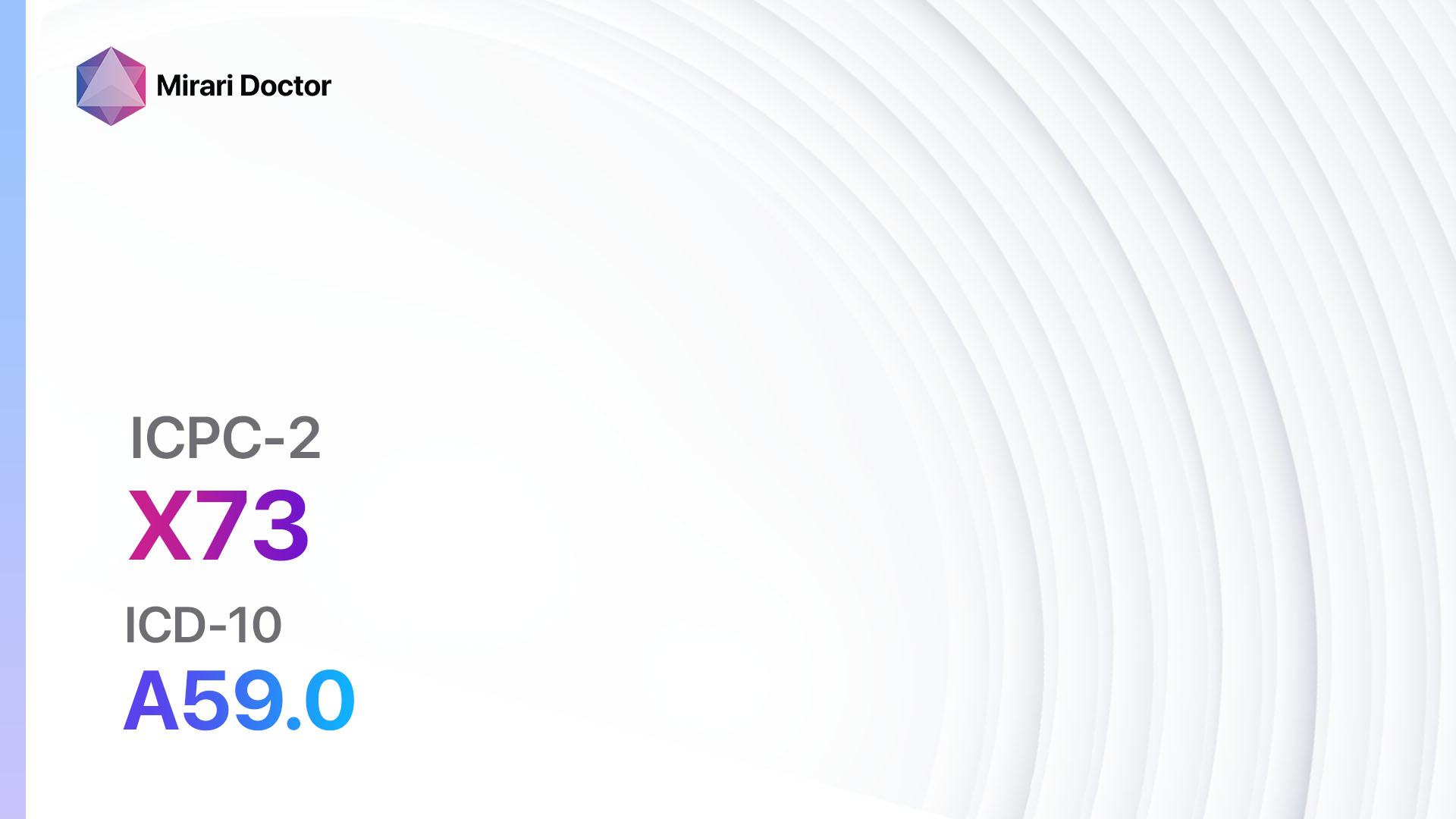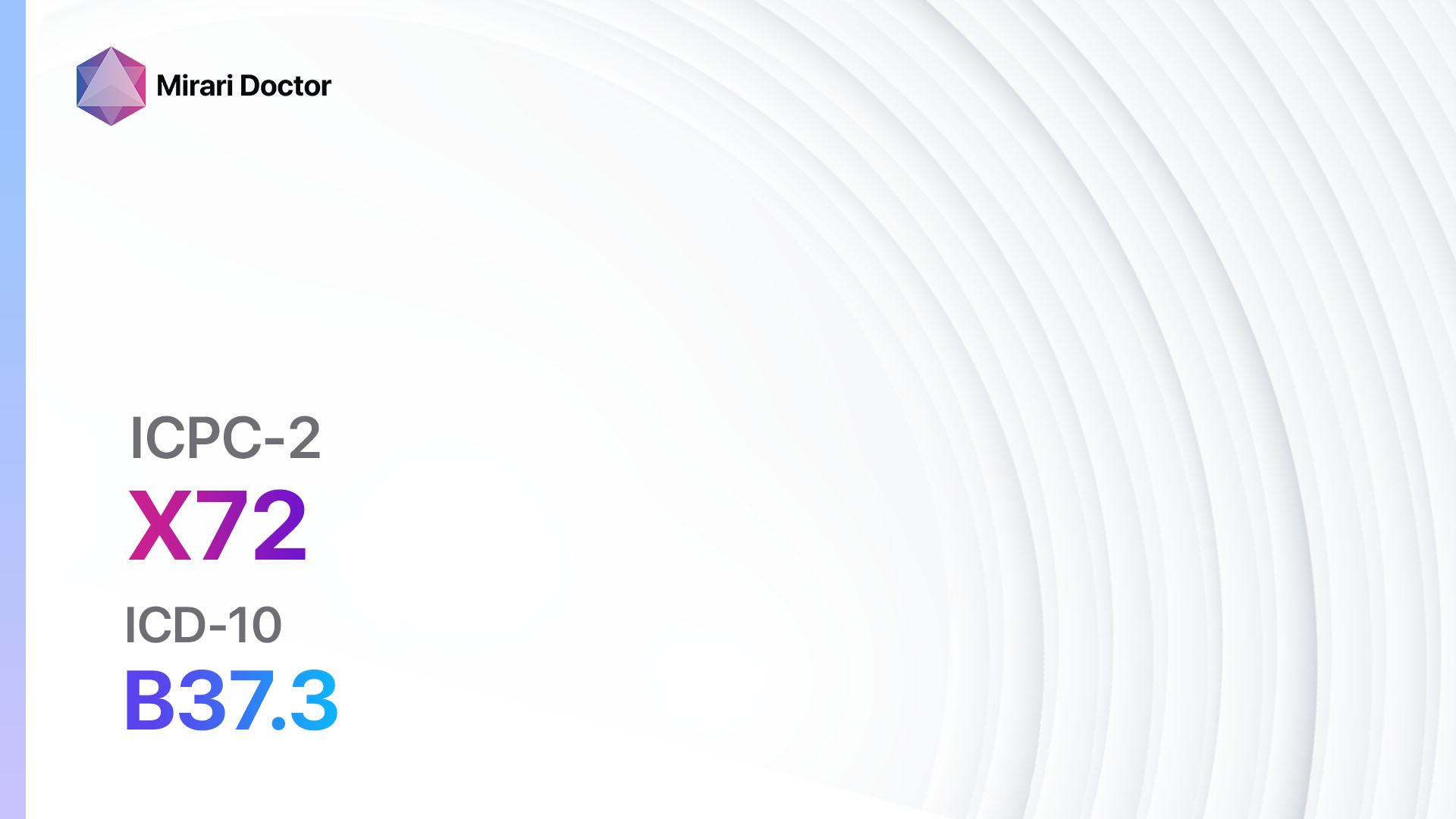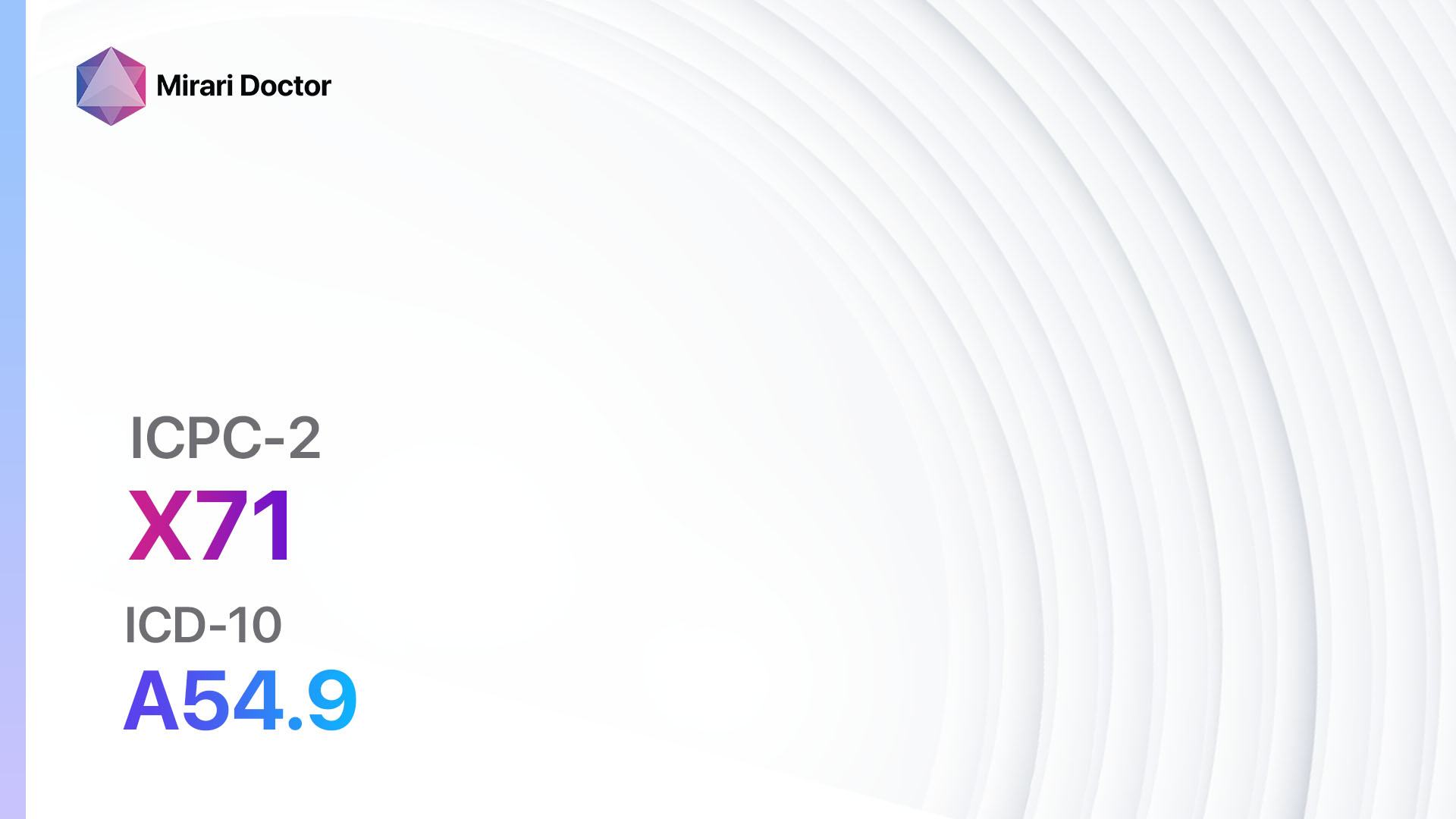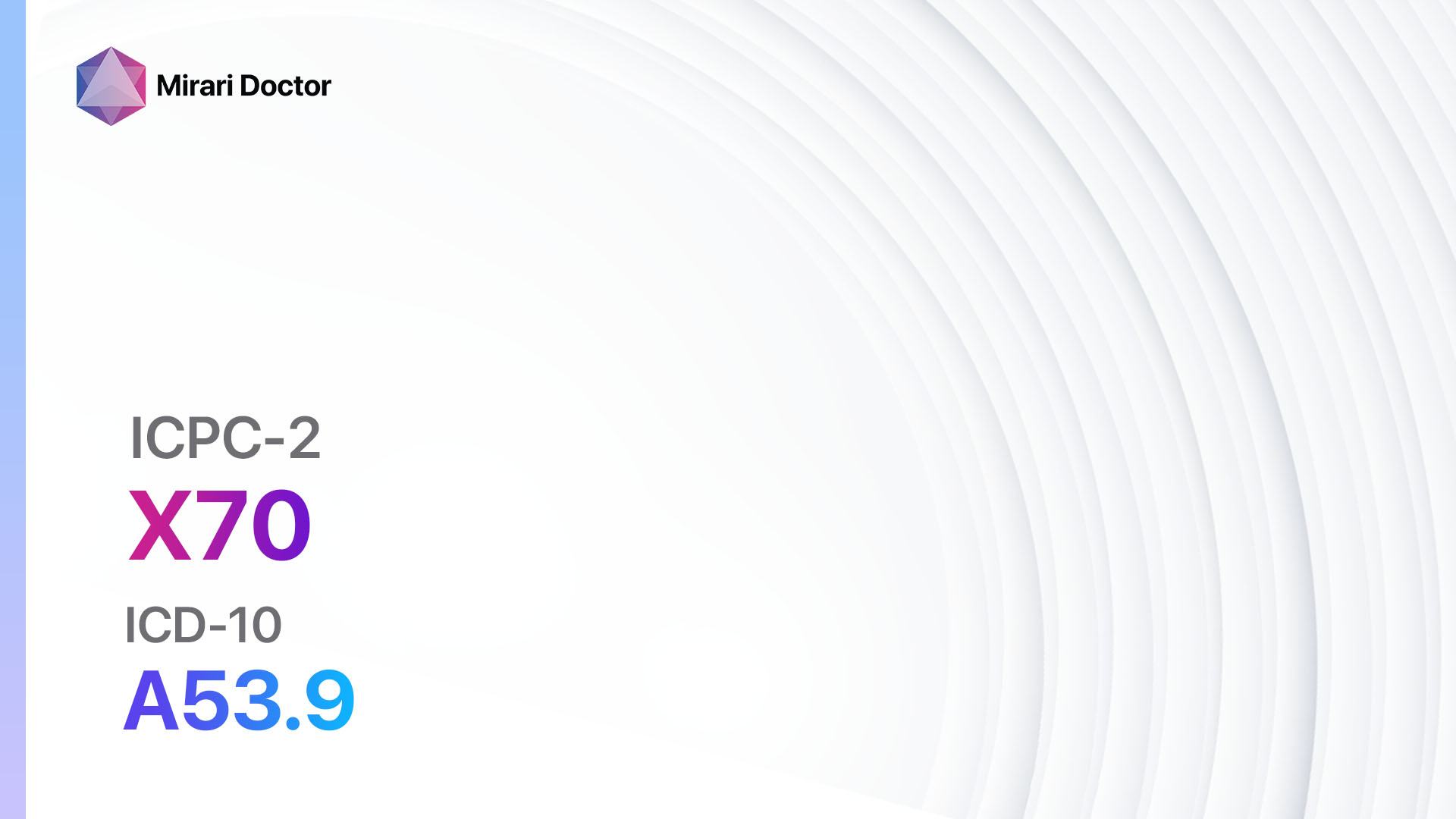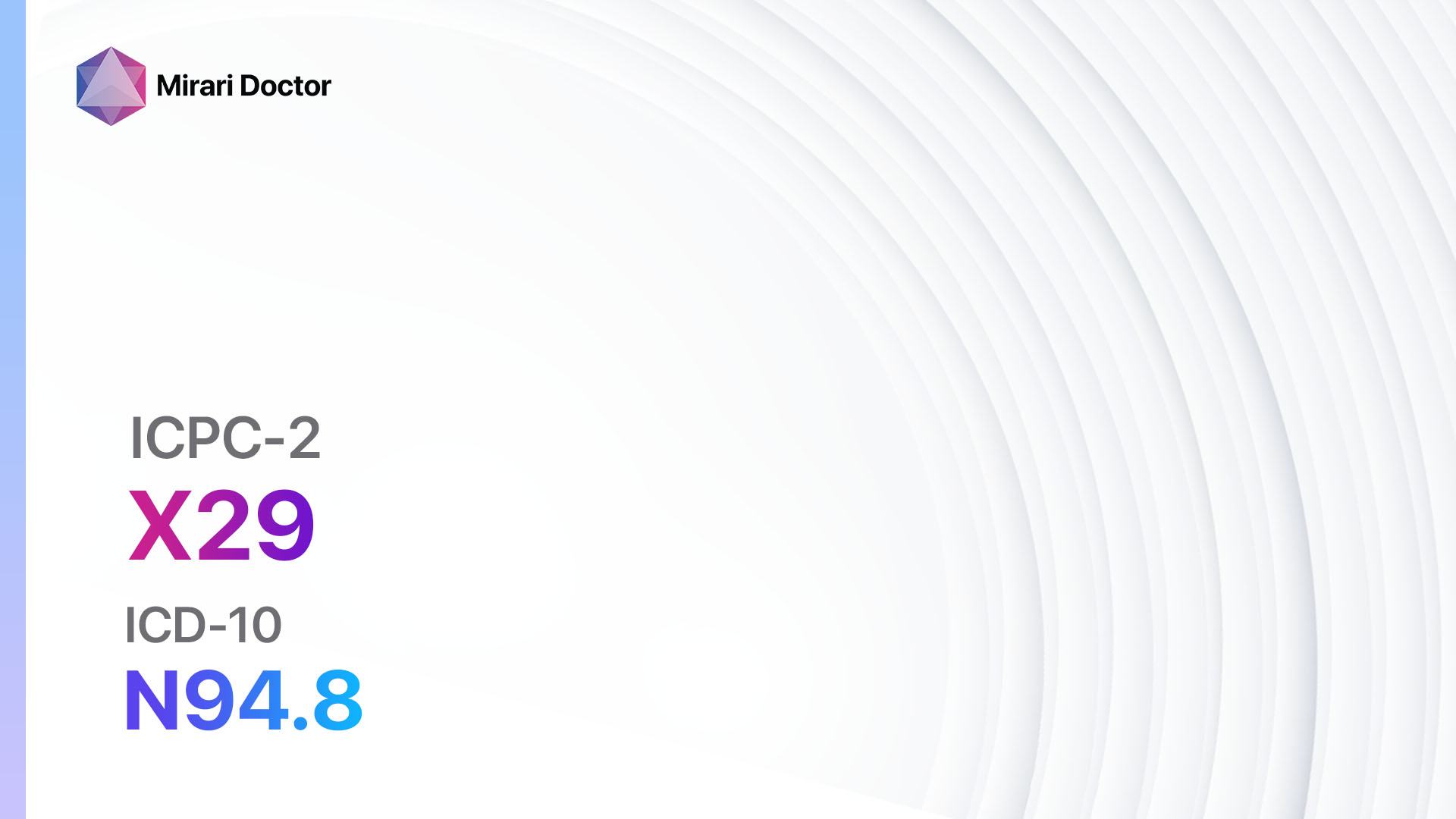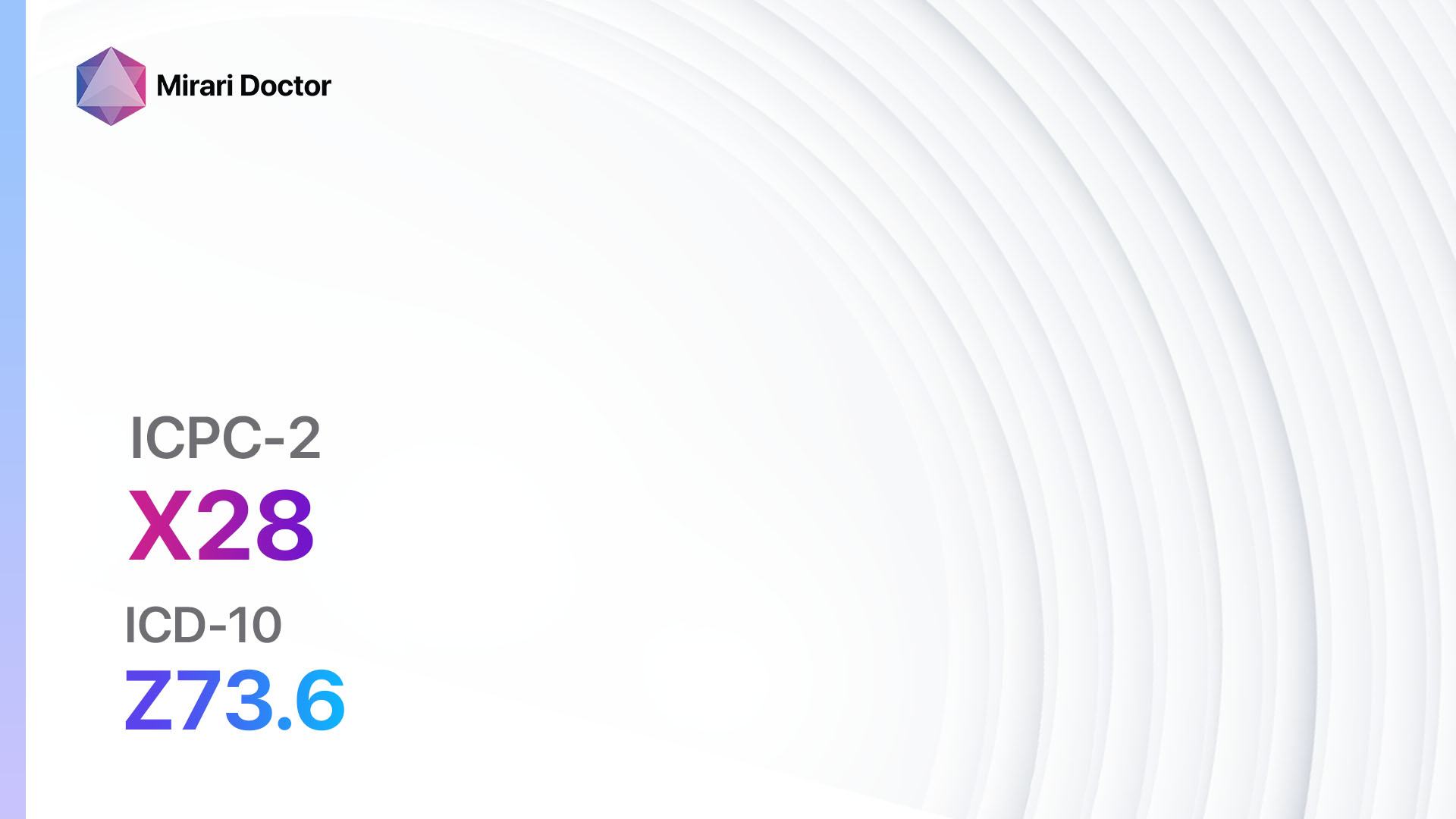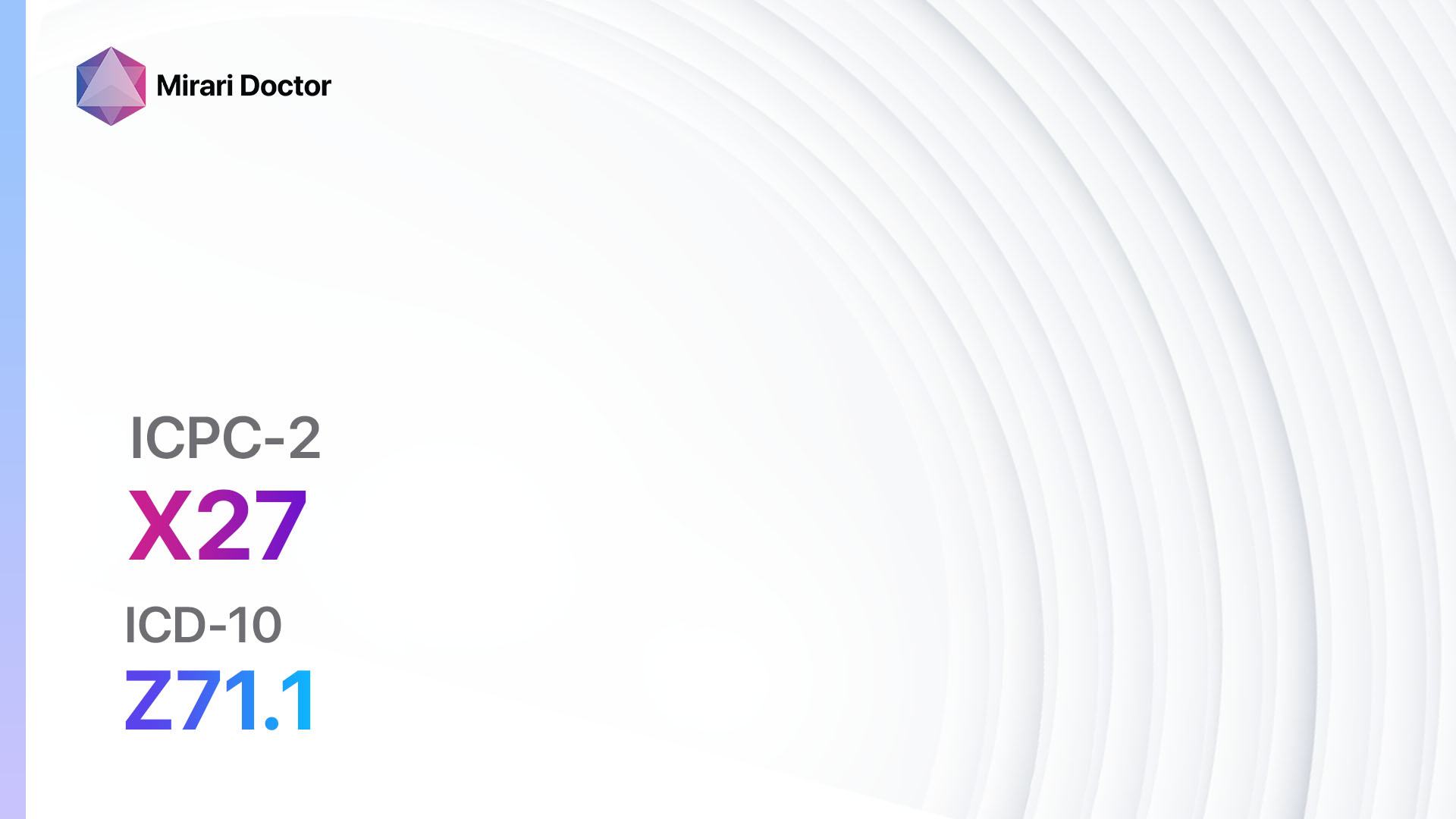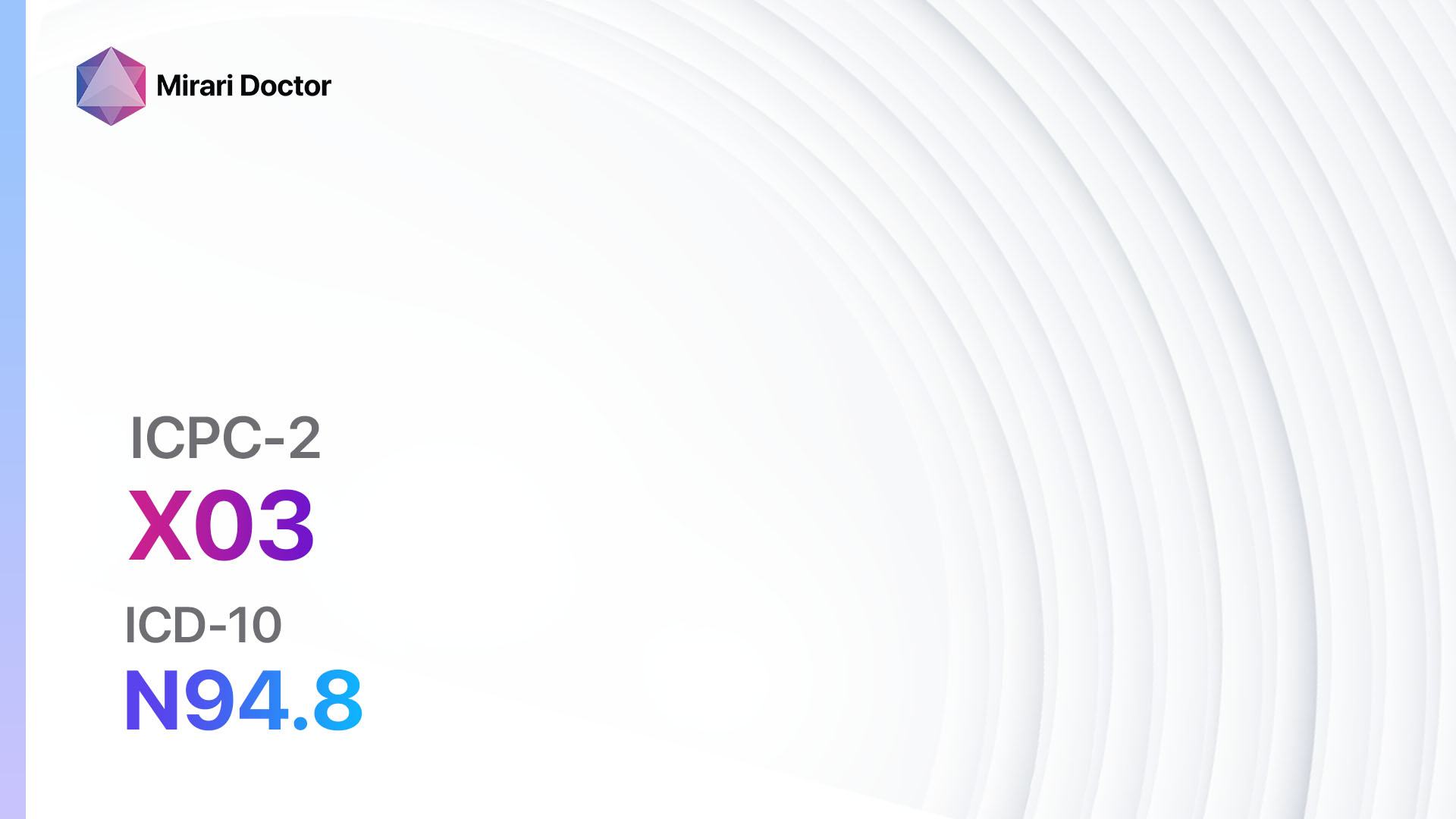
Introduction
Intermenstrual pain, also known as intermenstrual bleeding or metrorrhagia, refers to abnormal bleeding or spotting that occurs between menstrual periods. It can be a distressing symptom for women and may indicate an underlying medical condition[1]. The aim of this guide is to provide healthcare professionals with a comprehensive approach to diagnosing and managing intermenstrual pain.
Codes
- ICPC-2 Code: X03 Intermenstrual pain
- ICD-10 Code: N94.8 Other specified conditions associated with female genital organs and menstrual cycle
Symptoms
- Abnormal bleeding or spotting between menstrual periods
- Vaginal discharge
- Pelvic pain or discomfort
- Changes in menstrual flow or duration[2]
Causes
- Hormonal imbalances: Fluctuations in estrogen and progesterone levels can disrupt the normal menstrual cycle and lead to intermenstrual pain.
- Uterine fibroids: Noncancerous growths in the uterus can cause abnormal bleeding and pain.
- Polyps: Small, benign growths in the lining of the uterus or cervix can result in intermenstrual bleeding.
- Infections: Sexually transmitted infections or pelvic inflammatory disease can cause inflammation and bleeding.
- Endometriosis: The presence of endometrial tissue outside the uterus can lead to abnormal bleeding and pain.
- Ovarian cysts: Fluid-filled sacs on the ovaries can cause hormonal imbalances and intermenstrual bleeding[3][4].
Diagnostic Steps
Medical History
- Gather information about the patient’s menstrual history, including the regularity of periods, duration, and flow.
- Ask about any recent changes in contraceptive methods or medications.
- Inquire about the presence of other symptoms such as pelvic pain, vaginal discharge, or pain during intercourse.
- Assess the patient’s sexual history and the possibility of sexually transmitted infections[5].
Physical Examination
- Perform a pelvic examination to assess the condition of the cervix, uterus, and ovaries.
- Look for any signs of infection, such as redness, swelling, or discharge.
- Palpate the abdomen to check for any abnormalities or tenderness[6].
Laboratory Tests
- Complete blood count (CBC): To check for anemia or signs of infection.
- Hormone levels: Measure estrogen, progesterone, and other hormone levels to assess for hormonal imbalances.
- Pap smear: To screen for cervical abnormalities or infection.
- Sexually transmitted infection (STI) testing: To rule out STIs as a cause of intermenstrual bleeding[7].
Diagnostic Imaging
- Transvaginal ultrasound: To visualize the uterus, ovaries, and any abnormalities such as fibroids or cysts.
- Hysteroscopy: A thin, lighted tube is inserted through the cervix to examine the inside of the uterus for polyps or other abnormalities.
- Magnetic resonance imaging (MRI): In cases where ultrasound or hysteroscopy is inconclusive, an MRI may provide more detailed images[8].
Other Tests
- Endometrial biopsy: If other tests are inconclusive, a small sample of the uterine lining may be taken for further analysis.
- Genetic testing: In rare cases, genetic testing may be recommended to rule out certain genetic conditions that can cause intermenstrual bleeding[9].
Follow-up and Patient Education
- Schedule a follow-up appointment to discuss the results of the diagnostic tests and develop a treatment plan.
- Provide education on menstrual hygiene and the importance of regular gynecological check-ups.
- Encourage the patient to keep a menstrual diary to track any changes in bleeding patterns or symptoms[10].
Possible Interventions
Traditional Interventions
Medications:
Top 5 drugs for intermenstrual pain:
- Combined oral contraceptives (e.g., Ethinyl estradiol and levonorgestrel):
- Cost: $20-$50 per month.
- Contraindications: History of blood clots, certain types of cancer, liver disease.
- Side effects: Nausea, breast tenderness, breakthrough bleeding.
- Severe side effects: Blood clots, stroke, heart attack.
- Drug interactions: Certain antibiotics, anticonvulsants.
- Warning: Increased risk of blood clots in smokers and women over 35 years old.
- Progestin-only contraceptives (e.g., Norethindrone):
- Cost: $15-$40 per month.
- Contraindications: History of blood clots, certain types of cancer, liver disease.
- Side effects: Irregular bleeding, weight gain, mood changes.
- Severe side effects: Blood clots, stroke, heart attack.
- Drug interactions: Certain antibiotics, anticonvulsants.
- Warning: May cause irregular bleeding.
- Nonsteroidal anti-inflammatory drugs (NSAIDs) (e.g., Ibuprofen, Naproxen):
- Cost: $5-$15 per month.
- Contraindications: History of stomach ulcers, kidney disease, bleeding disorders.
- Side effects: Upset stomach, heartburn, dizziness.
- Severe side effects: Stomach bleeding, kidney problems.
- Drug interactions: Blood thinners, certain antidepressants.
- Warning: Prolonged use may increase the risk of heart attack or stroke.
- Tranexamic acid:
- Cost: $50-$100 per month.
- Contraindications: History of blood clots, active thromboembolic disease.
- Side effects: Upset stomach, headache, muscle pain.
- Severe side effects: Blood clots, allergic reactions.
- Drug interactions: Certain anticoagulants, hormonal contraceptives.
- Warning: Should not be used in patients with a history of blood clots.
- Gonadotropin-releasing hormone (GnRH) agonists (e.g., Leuprolide):
- Cost: $300-$600 per month.
- Contraindications: Pregnancy, breastfeeding, osteoporosis.
- Side effects: Hot flashes, mood changes, decreased libido.
- Severe side effects: Bone loss, increased risk of fractures.
- Drug interactions: None reported.
- Warning: Long-term use may lead to bone loss.
Alternative Drugs:
- Danazol: A synthetic hormone that suppresses the production of estrogen and progesterone.
- Selective estrogen receptor modulators (SERMs) (e.g., Tamoxifen): May help regulate hormonal imbalances.
- Antibiotics: If an infection is identified as the cause of intermenstrual bleeding.
Surgical Procedures:
- Dilation and curettage (D&C): A procedure to remove tissue from the uterus. Cost: $2,000-$5,000.
- Endometrial ablation: A minimally invasive procedure to destroy the lining of the uterus. Cost: $5,000-$10,000.
- Hysterectomy: Surgical removal of the uterus. Cost: $10,000-$20,000.
Alternative Interventions
- Acupuncture: May help regulate hormonal imbalances and reduce pain. Cost: $60-$120 per session.
- Herbal supplements: Certain herbs, such as chasteberry or black cohosh, may have potential benefits for hormonal regulation. Cost: Varies depending on the specific supplement.
- Stress reduction techniques: Yoga, meditation, or relaxation exercises may help manage symptoms. Cost: Varies depending on the chosen method.
- Dietary changes: A diet rich in fruits, vegetables, and whole grains may help regulate hormonal imbalances. Cost: Varies depending on food choices.
- Exercise: Regular physical activity can help regulate hormones and reduce pain. Cost: Varies depending on the chosen activity.
Lifestyle Interventions
- Maintain a healthy weight: Excess weight can contribute to hormonal imbalances and exacerbate intermenstrual pain. Cost: Varies depending on individual needs and preferences.
- Avoid smoking and excessive alcohol consumption: These habits can disrupt hormonal balance and worsen symptoms. Cost: Varies depending on individual habits.
- Practice stress management techniques: Stress can worsen hormonal imbalances and increase pain. Cost: Varies depending on chosen techniques.
- Get regular exercise: Physical activity can help regulate hormones and reduce pain. Cost: Varies depending on chosen activities.
- Practice good menstrual hygiene: Using sanitary products and changing them regularly can help prevent infections. Cost: Varies depending on chosen products.
It is important to note that the cost ranges provided are approximate and may vary depending on the location and availability of the interventions. It is recommended to consult with a healthcare professional for personalized treatment options and cost estimates.
Mirari Cold Plasma Alternative Intervention
Understanding Mirari Cold Plasma
- Safe and Non-Invasive Treatment: Mirari Cold Plasma is a safe and non-invasive treatment option for various skin conditions. It does not require incisions, minimizing the risk of scarring, bleeding, or tissue damage.
- Efficient Extraction of Foreign Bodies: Mirari Cold Plasma facilitates the removal of foreign bodies from the skin by degrading and dissociating organic matter, allowing easier access and extraction.
- Pain Reduction and Comfort: Mirari Cold Plasma has a local analgesic effect, providing pain relief during the treatment, making it more comfortable for the patient.
- Reduced Risk of Infection: Mirari Cold Plasma has antimicrobial properties, effectively killing bacteria and reducing the risk of infection.
- Accelerated Healing and Minimal Scarring: Mirari Cold Plasma stimulates wound healing and tissue regeneration, reducing healing time and minimizing the formation of scars.
Mirari Cold Plasma Prescription
Video instructions for using Mirari Cold Plasma Device – X03 Intermenstrual pain (ICD-10:N94.8)
| Mild | Moderate | Severe |
| Mode setting: 2 (Wound Healing) Location: 2 (Prostate & Uterus) Morning: 15 minutes, Evening: 15 minutes |
Mode setting: 2 (Wound Healing) Location: 2 (Prostate & Uterus) Morning: 30 minutes, Lunch: 30 minutes, Evening: 30 minutes |
Mode setting: 2 (Wound Healing) Location: 2 (Prostate & Uterus) Morning: 30 minutes, Lunch: 30 minutes, Evening: 30 minutes |
| Mode setting: 7 (Immunotherapy) Location: 1 (Sacrum) Morning: 15 minutes, Evening: 15 minutes |
Mode setting: 7 (Immunotherapy) Location: 1 (Sacrum) Morning: 30 minutes, Lunch: 30 minutes, Evening: 30 minutes |
Mode setting: 7 (Immunotherapy) Location: 1 (Sacrum) Morning: 30 minutes, Lunch: 30 minutes, Evening: 30 minutes |
| Mode setting: 7 (Immunotherapy) Location: 1 (Sacrum) Morning: 15 minutes, Evening: 15 minutes |
Mode setting: 7 (Immunotherapy) Location: 1 (Sacrum) Morning: 30 minutes, Lunch: 30 minutes, Evening: 30 minutes |
Mode setting: 7 (Immunotherapy) Location: 1 (Sacrum) Morning: 30 minutes, Lunch: 30 minutes, Evening: 30 minutes |
| Total Morning: 45 minutes approx. $7.50 USD, Evening: 45 minutes approx. $7.50 USD |
Total Morning: 90 minutes approx. $15 USD, Lunch: 90 minutes approx. $15 USD, Evening: 90 minutes approx. $15 USD |
Total Morning: 90 minutes approx. $15 USD, Lunch: 90 minutes approx. $15 USD, Evening: 90 minutes approx. $15 USD |
| Usual treatment for 7-60 days approx. $105 USD – $900 USD | Usual treatment for 6-8 weeks approx. $1,890 USD – $2,520 USD |
Usual treatment for 3-6 months approx. $4,050 USD – $8,100 USD
|
 |
|
Use the Mirari Cold Plasma device to treat Intermenstrual pain effectively.
WARNING: MIRARI COLD PLASMA IS DESIGNED FOR THE HUMAN BODY WITHOUT ANY ARTIFICIAL OR THIRD PARTY PRODUCTS. USE OF OTHER PRODUCTS IN COMBINATION WITH MIRARI COLD PLASMA MAY CAUSE UNPREDICTABLE EFFECTS, HARM OR INJURY. PLEASE CONSULT A MEDICAL PROFESSIONAL BEFORE COMBINING ANY OTHER PRODUCTS WITH USE OF MIRARI.
Step 1: Cleanse the Skin
- Start by cleaning the affected area of the skin with a gentle cleanser or mild soap and water. Gently pat the area dry with a clean towel.
Step 2: Prepare the Mirari Cold Plasma device
- Ensure that the Mirari Cold Plasma device is fully charged or has fresh batteries as per the manufacturer’s instructions. Make sure the device is clean and in good working condition.
- Switch on the Mirari device using the power button or by following the specific instructions provided with the device.
- Some Mirari devices may have adjustable settings for intensity or treatment duration. Follow the manufacturer’s instructions to select the appropriate settings based on your needs and the recommended guidelines.
Step 3: Apply the Device
- Place the Mirari device in direct contact with the affected area of the skin. Gently glide or hold the device over the skin surface, ensuring even coverage of the area experiencing.
- Slowly move the Mirari device in a circular motion or follow a specific pattern as indicated in the user manual. This helps ensure thorough treatment coverage.
Step 4: Monitor and Assess:
- Keep track of your progress and evaluate the effectiveness of the Mirari device in managing your Intermenstrual pain. If you have any concerns or notice any adverse reactions, consult with your health care professional.
Note
This guide is for informational purposes only and should not replace the advice of a medical professional. Always consult with your healthcare provider or a qualified medical professional for personal advice, diagnosis, or treatment. Do not solely rely on the information presented here for decisions about your health. Use of this information is at your own risk. The authors of this guide, nor any associated entities or platforms, are not responsible for any potential adverse effects or outcomes based on the content.
Mirari Cold Plasma System Disclaimer
- Purpose: The Mirari Cold Plasma System is a Class 2 medical device designed for use by trained healthcare professionals. It is registered for use in Thailand and Vietnam. It is not intended for use outside of these locations.
- Informational Use: The content and information provided with the device are for educational and informational purposes only. They are not a substitute for professional medical advice or care.
- Variable Outcomes: While the device is approved for specific uses, individual outcomes can differ. We do not assert or guarantee specific medical outcomes.
- Consultation: Prior to utilizing the device or making decisions based on its content, it is essential to consult with a Certified Mirari Tele-Therapist and your medical healthcare provider regarding specific protocols.
- Liability: By using this device, users are acknowledging and accepting all potential risks. Neither the manufacturer nor the distributor will be held accountable for any adverse reactions, injuries, or damages stemming from its use.
- Geographical Availability: This device has received approval for designated purposes by the Thai and Vietnam FDA. As of now, outside of Thailand and Vietnam, the Mirari Cold Plasma System is not available for purchase or use.
References
- Munro, M. G., Critchley, H. O., & Fraser, I. S. (2011). The FIGO classification of causes of abnormal uterine bleeding in the reproductive years. Fertility and Sterility, 95(7), 2204-2208.
- Sweet, M. G., Schmidt-Dalton, T. A., Weiss, P. M., & Madsen, K. P. (2012). Evaluation and management of abnormal uterine bleeding in premenopausal women. American Family Physician, 85(1), 35-43.
- Whitaker, L., & Critchley, H. O. (2016). Abnormal uterine bleeding. Best Practice & Research Clinical Obstetrics & Gynaecology, 34, 54-65.
- Bitzer, J., & Heikinheimo, O. (2015). Contraception and intermenstrual bleeding. European Journal of Contraception & Reproductive Health Care, 20(5), 394-400.
- Matteson, K. A., & Clark, M. A. (2010). Questioning our questions: do frequently asked questions adequately cover the aspects of women’s lives most affected by abnormal uterine bleeding? Opinions of women with abnormal uterine bleeding participating in focus group discussions. Women & Health, 50(2), 195-211.
- Sriprasert, I., Pakrashi, T., Kimble, T., & Archer, D. F. (2017). Heavy menstrual bleeding diagnosis and medical management. Contraception and Reproductive Medicine, 2(1), 20.
- Munro, M. G., Critchley, H. O., Broder, M. S., & Fraser, I. S. (2011). FIGO classification system (PALM-COEIN) for causes of abnormal uterine bleeding in nongravid women of reproductive age. International Journal of Gynecology & Obstetrics, 113(1), 3-13.
- Maheux-Lacroix, S., Li, F., Laberge, P. Y., & Abbott, J. (2016). Imaging for polyps and leiomyomas in women with abnormal uterine bleeding: a systematic review. Obstetrics & Gynecology, 128(6), 1425-1436.
- Deligeoroglou, E., Karountzos, V., & Creatsas, G. (2013). Abnormal uterine bleeding and dysfunctional uterine bleeding in pediatric and adolescent gynecology. Gynecological Endocrinology, 29(1), 74-78.
- Matteson, K. A., Rahn, D. D., Wheeler, T. L., Casiano, E., Siddiqui, N. Y., Harvie, H. S., … & Murphy, M. (2013). Nonsurgical management of heavy menstrual bleeding: a systematic review. Obstetrics & Gynecology, 121(3), 632-643.
Related articles
Made in USA


